#toona sinensis
Explore tagged Tumblr posts
Text
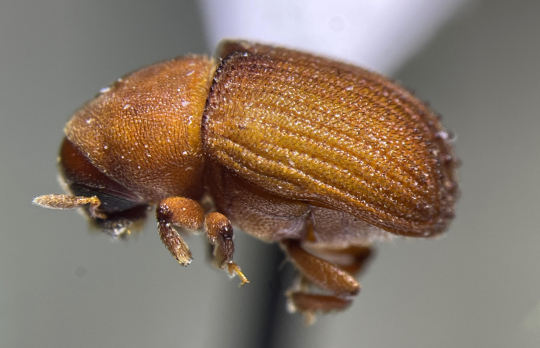
i recently solved a fun little bug mystery at work and i thought it might be interesting to write up a step-by-step narrative of how i did so, as a sort of example of the kinds of things i get to do for my job. this is a stupidly long post because i have no editorial self-control so i'm putting the rest under a cut.
the above insect is a bark beetle, one of a series of 6 specimens i found in a drawer at work. they did not have species labels on them, and the collection labels indicated that they were collected in 1997 from "Chinese Cedrus used for artifical christmas trees." the infested wood had been intercepted and the beetles collected and pinned, but whoever was working in the lab at the time wasn't able to suss out the species, which is extremely reasonable because even IDing american bark beetles to species can be a massive pain in the ass, let alone ones from asia.
the beetles were clearly in the genus Phloeosinus based on the shape of the antennae and the large spines on the elytral declivity (the ass area), and whoever pinned them at least got them that far themselves, but determining the actual species was going to be a lot harder. even american beetles in this genus can be devilishly hard to confidently ID to species since they often look alike and also are quite morphologically variable in ways the bleed into each other. they are pretty cool though and those ass spines are usually critical in species-level identification

btw since i'm going to be writing out this word a lot in this post, it's pronounced roughly as "flea-o-sign-us" if you're curious.
determining bark beetle species is often made much easier by knowing what tree the beetle came out of since most bark beetles (but not ambrosia beetles, which are also scolytid/scolytine beetles but a whole other can of worms grubs) are highly host-specific, usually being adapted to only a certain tree species or genus or small group of related genera.
so Cedrus is the genus for eurasian cedar trees, and there is one species of Cedrus native to china, Cedrus deodara, but that seems like an odd choice of plant to harvest and send to america for artificial christmas tree trunks. most actual Cedrus species are from the mediterranean area. however there are also some chinese trees in the cypress family Cupressaceae (+Taxodiaceae) that are called cedars, and in fact most species of Phloeosinus are exclusively found in trees in this family. one likely species is Cunninghamia lanceolata, traditionally called "chinese fir" despite not being a fir but also more recently marketed as "chinese cedar" because that's how common names for species go.
oh and there is also the tree Toona sinensis in the family Meliaceae that's ALSO sometimes called "chinese cedar" for some reason but more importantly also called "beef and onion plant" lmao, but that was an even worse candidate for an artificial christmas tree trunk and also not a known host for the beetles. easily discounted but i had a laugh.
so my first angle of attack was to assume that the collection labels were correct and the beetles were in fact from a Cedrus tree. i was able to find a list of about a half dozen Phloeosinus species known to attack Cedrus cedars, but none of them were native to china. this would most likely mean that one of the mediterranean species had been transplanted to china for cultivation, which is entirely plausible. after digging though a bunch of literature i wasn't able to find a good key for Phloeosinus species in the entire area i wanted, but found a couple regional keys covering geographic ranges that when combined covered about what i wanted. for non-biologists, this is what a species key looks like:

sort of a choose your own adventure kind of thing but for determining a creature's true identity. anyway none of the results i got from these keys led to species who's descriptions matched the one that i had. i should also mention that my specimens had a rather distinctive feature unlike any other Phloeosinus species i'd ever seen before, which was an elytral vestiture consisting of these really funky little black explanate scales:
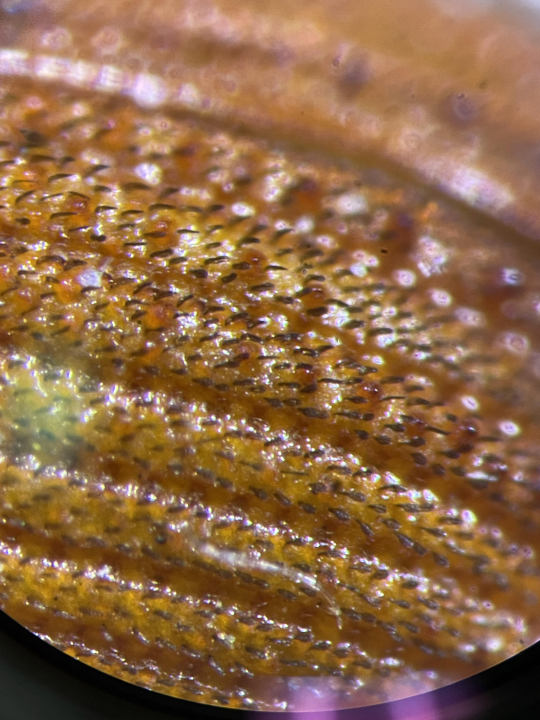

most Phloeosinus species have some kind of vestiture on their elytra but all the ones i'm familiar with have the hairs and scales light-colored and never shaped anything like this, so i figured that the description of the correct species would surely mention these scales.
so anyway dissatisfied with this avenue, i decided that the next most likely option is that whoever made the labels for the specimens was told that they had come from "chinese cedar" by the importer and had just assumed that meant Cedrus but it was actually one of the cypress family cedars. again most of the described species do in fact use Cupressaceae as hosts.
so next i found this UN report with a (hopefully) comprehensive list of all non-EU bark and ambrosia beetle species that attacked conifer trees. i culled from that a list of Phloeosinus species listed as coming from "asia." since that was too broad of an area, i then looked up all of these species in the species catalogues listed in the report, mostly Alonso-Zarazag et al (2007), though some were also listed in Wood and Bright (1992) or Bright and Skidmore (2002), which i happen to have physical copes of. from these i could narrow the list down to just species found in china.
now things became difficult because there are no keys to chinese Phloeosinus, or at least none in english. also even just written descriptions of many of these species were impossible to find because they were all written like 60-100 years ago and usually in chinese or german or french and had never been translated or uploaded anywhere online. likewise almost none of them had research-grade (or any) photos anywhere online.
so after hours of fruitless digging, the best i could come up with was a guide to scolytine beetles of korea (PDF link), which contained a key with a handful of the species on my list and did include english descriptions of these. now one of the species in the guide, P. perlatus, IS DESCRIBED as having dark scales, and my specimens did seem to land on that species when i ran them through the key. that's promising! and the hosts were on my list of possible non-Cedrus chinese cedars! also promising! buuuut something just didn't sit right with me. parts of the species description in that paper just didn't seem to quite match my specimens, like for example the size was a little off, described as being 2.4-3.4mm long, while all of mine were in the 3.3-3.6 range. plus the photos of the species, while distressingly low-resolution, just didn't look like mine.
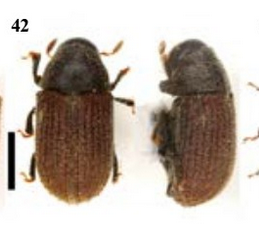
okay so that was dissatisfying. i'd managed to whittle down my list of suspects a good deal from what little scraps of information i could find about them through my sleuthing, either the wrong hosts or the ones that did have english descriptions available online like in that korean guide didn't fit, but i was still left with several possible candidates and no way to narrow it down further, of course this all assuming that the beetles i had on my hands even were a species that had been scientifically described and named. bark beetles are a huge group of critters and many are quite understudied, especially in asia, and a bunch of new species are described every year!
i was about ready to just give up, but then by coincidence i had a reason to email a couple of high-level bark beetle researchers about a different beetle mystery i was also working on, which was in a group that they were the authorities on. on a whim, i mentioned my Phloeosinus conundrum to them to see if they had any ideas and they recommended i contact Dr. Roger Beaver. yeah, i know right? fucking kickass name i'm so jealous. sidenote: it's so funny how many bark beetle researchers have extremely appropriate names, like two of the biggest names in the field are Steve Wood and Dave Wood. no relation.
so anyway i contacted Dr Beaver, who had done some research on east asian Phloeosinus in the past and he was kind enough to send me an unpublished provisional key to chinese species that he had written up a few years ago. using that key, i ended up at "P. pertuberculatus (?=sinensis)" which means that there was some suspicion that P. pertuberculatus and P. sinensis were the same species, just described and named independently by two different entomologists (Hans Eggers and Karl Eduard Schedl respectively), as often happened, especially in the glory days of insane 18th-20th century european entomologists describing literally thousands of new species during their careers.
now these two species WERE both on my final list of suspects of chinese Phloeosinus species that hadn't otherwise been eliminated for one reason or another, and both had Cunninghamia "cedar" trees as known hosts. Dr Beaver was then kind enough to scan and send me the original descriptions of these two species:
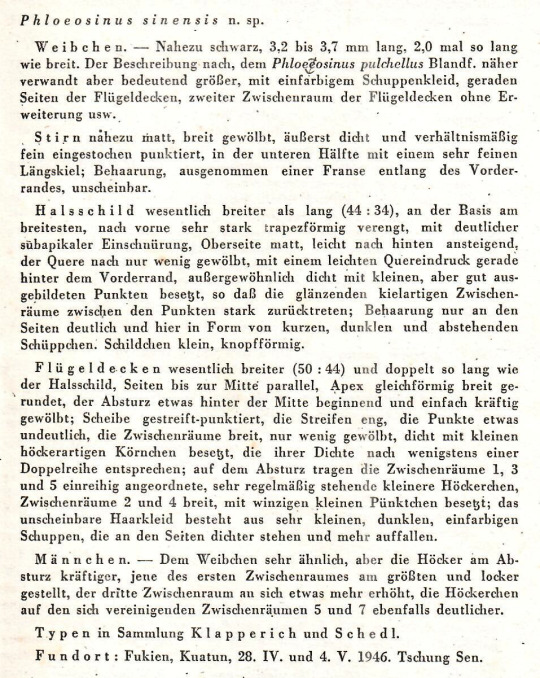
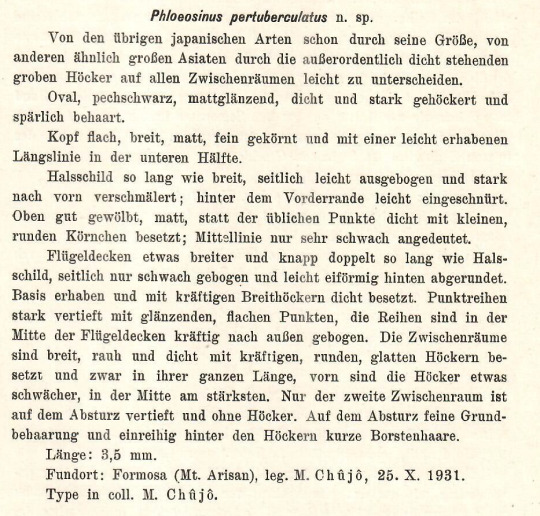
which i was able to use google translate on:
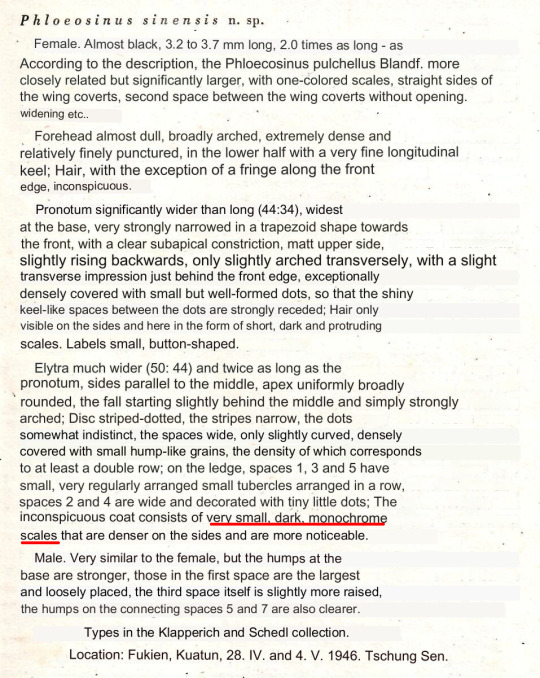
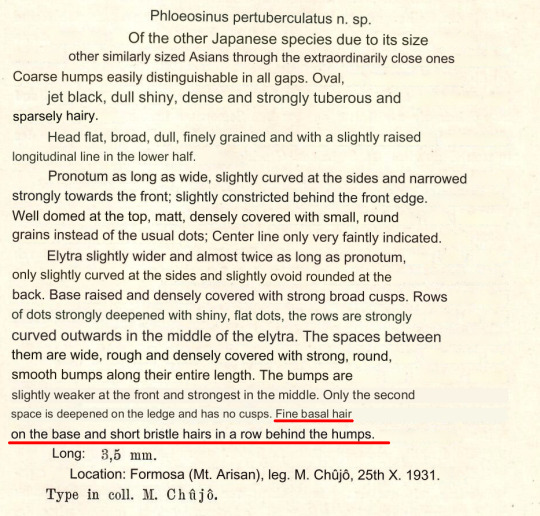
not the nicest translation but still an admirable attempt on google's part to deal with all the entomological jargon, and most importantly the description of the elytral scales on P. sinensis definitely seems to match my specimens more than the pertuberculatus. plus i found a paper on taiwanese bark beetles (PDF) coauthored by Dr Beaver that had a (also distressingly low-resolution) photo of pertuberculatus that didn't seem to match my specimens:

aaand finally: i'd been trying for days to access the webpage of a chinese museum that popped up as the only notable result on a google image search for P. sinensis but every time the website would time out and the cached version of the image was too small to make out any details on, but it finally occurred to me this evening that the reason was probably because my work computer or work wifi was just automatically blocking chinese websites because of america's insane paranoia about chinese spying, and sure enough i opened it up on my home computer and it fucking worked!
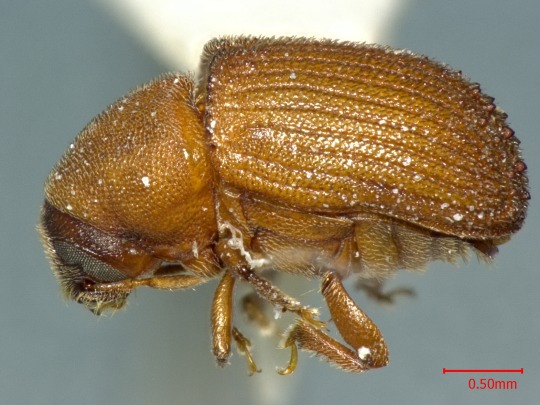

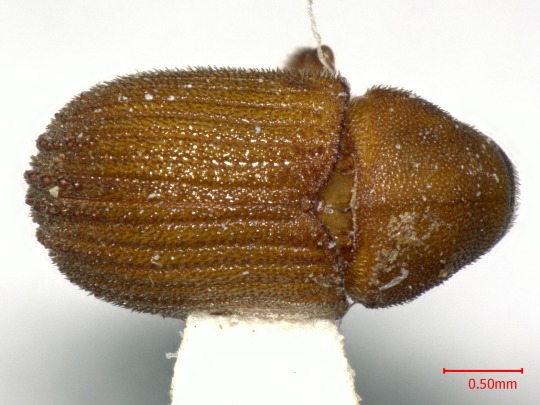
that's a pretty fucking bang-on match for my specimens! the scales look right, the color is right, the size is right, the ass bumps are right, the host is right, the geography is right, and the translated description otherwise seems to match! here's mine again so you don't have to scroll all the way up:

so i'm calling this 26-year mystery solved! not all of the bug puzzles i've worked on have had as meandering of a path to their conclusion as this, but i thought that this one did display a good number of the different methods i use. the biggest thing that was missing was me wandering into my lab's massive library of old dusty entomology journals stretching back over a century and digging out some old article that never got scanned and put online, as often happens, but in this case since the bugs were asian and out library mostly covers north american entomology that wasn't going to be very fruitful.
hopefully this was interesting to... somebody besides myself. if you've read this far and weren't bored to tears then congratulations you probably have the same kind of brain damage as me!
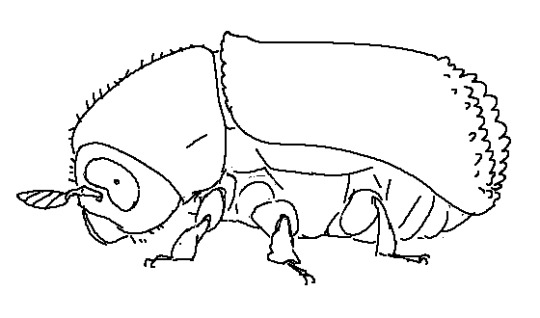
310 notes
·
View notes
Text

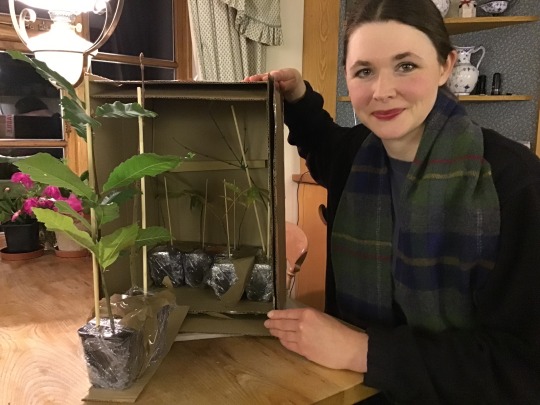
Happy National Tree Week in the UK!
Can Black Friday be green? It can if you go on a shopping spree at @jurassic_plants ! The average tree absorbs around 10 kilograms (22 pounds) of atmospheric carbon per year, so planting many trees on your property can add up to an positive impact on reducing your carbon footprint in the long term.
Here is my haul from the Black Friday sale at Jurassic Plants, one of my favourite online plant shops in the UK. Late autumn is a great time to buy seedling trees since the deciduous species are less likely to be damaged in transport because they have already shed their leaves and are dormant. In addition, the trees can be planted in larger pots so they are ready to start growing as soon as they break dormancy in spring. In a plant biology context, dormancy is a temporary period of slowed growth which usually coincides with the winter season. Dormancy can also occur in plants living in environments with designated dry seasons or other times of the year that are generally unsuitable for growth. For most deciduous trees, the trigger is falling temperatures and shorter day lengths.
This year, I welcomed the following species to my ever-expanding family of trees: Castanea sativa - Sweet Chestnut Acer sterculiaceum - Himalayan, Pungent Maple Zelkova serrata - Japanese Zelkova Zanthoxylum piperitum - Japanese Pepper Tree Vitex agnus-castus - Chaste Tree Toona sinensis - Onion Tree, Chinese Cedar, Chinese Mahogany Sorbus domestica - True Service Tree, Sorb Tree Liquidambar styraciflua - Sweet Gum Tree Ginkgo biloba - Maidenhair Tree Cydonia oblonga - Common Quince Cornus mas - Cornelian Cherry Cercidiphyllum japonicum - Toffee Apple Tree, Katsura Tree Cephalotaxus harringtonia - Japanese Plum Yew Aesculus glabra - Ohio Buckeye Aesculus californica - Californian Chestnut Acer tataricum subsp. ginnala - Amur Maple Acer monspessulanum - Montpellier Maple Acer cissifolium - Ivy Leaved Maple
#katia plant scientist#botany#plant biology#plants#plant science#katia hougaard#self portrait#cottagecore#kitchen#trees#seedlings#carbon footprint#reduce carbon footprint#tree planting#go green#green living#environmentalism#environmental impact#positive impact#gardening#plant scientist#botanist#national tree week
3 notes
·
View notes
Text
Found out about yet another very neat cold tolerant edible plant-- a tree of which the leaves are eaten as a vegetable in large parts of the world. It also has very beautiful reddish wood. It sounds like such a staple of various cuisines/cultures it's really kind of funny i'd never heard of it before. But here we are. Seedlings are sold locally here for very little so i might try to grow one. 👀
4 notes
·
View notes
Text
The Chinese Toon Tree, a nutritional superfood and eco-friendly marvel, offers culinary delights, historical significance, and environmental benefits, making it essential for sustainable practices and health-conscious diets.
0 notes
Text
#Chinese Cuisine#Chinese Toon#Culinary Herbs#Health Benefits#Herbal Remedies#Nature#Nutrition#Organic Food#Superfood#Sustainable Eating
0 notes
Text
110cm Artificial Toona Sinensis Tree Evergreen
A realistic plant, measuring 110cm tall x 60cm wide when arranged as shown in our photos. It comes fully potted in a plastic weighted pot which measures 15cm (d) x 13cm (h) approx. Requires no maintenance or watering and is ready to display straight out of the box. Entirely artificial components. These trees are designed to be put inside a larger planter to display and you can add soil – gravel…
0 notes
Text
Ailanthus altissima : Confusions possibles
See on Scoop.it - EntomoScience

Ailanthus altissima - Wikipédia
Ailante glanduleux Ailanthus altissima f. erythrocarpa (Carrière) Rehder Ailanthus altissima var. erythrocarpa (Carrière) Rehder Ailanthus altissima var. glutinosa V. L. G & F. B. N. Ailanthus altissima var. leucoxyla B. C. Ding & T. B. Chao Ailanthus altissima var. microphylla B. C. Ding & T. B. Chao Ailanthus altissima var.
L'Ailante glanduleux est souvent confondu avec le Sumac vinaigrier (Rhus typhina), surtout quand les arbres sont jeunes, car leurs feuillages sont très semblables et ce sont des plantes envahissantes qui colonisent toutes deux les talus et bords de routes. En revanche, le bord des folioles du Sumac est dentelé ; un Sumac adulte ne dépasse guère cinq mètres, tandis que l'Ailante peut mesurer plus de vingt mètres de hauteur ; leurs fructifications sont aussi bien différentes. Cette confusion entre les deux espèces a pu faire accuser à tort l'Ailante glanduleux d'être toxique.
Confusions fréquentes
Wikipédia, version du 6 juillet 2024 à 20:48
Autres espèces
Une confusion est également possible avec l'Acajou de Chine (Toona sinensis), dont l'écorce est rugueuse une fois le tronc assez développé et les feuilles une odeur d'oignon24, mais aussi avec le Vernis du Japon (Toxicodendron vernicifluum)3, ou encore certains jeunes noyers comme le Noyer noir (Juglans nigra), le Noyer cendré (Juglans cinerea) et le Noyer du Japon (Juglans ailantifolia). Ces espèces appartenant à des familles différentes se trouvent assez fréquemment plantées comme arbres d'ornement dans les pays tempérés, et sont parfois naturalisées24. Parmi les espèces indigènes en Europe, l'Ailante glanduleux peut être confondu dans une moindre mesure avec le Frêne élevé (Fraxinus excelsior), qui se distingue par ses bourgeons noirs et ses feuilles imparipennées à 6 paires de folioles au maximum23.
0 notes
Text
Integrated Transcriptomic and Metabolomic Analysis Reveal the Underlying Mechanism of Anthocyanin Biosynthesis in Toona sinensis Leaves
http://dlvr.it/Sy6dSH
0 notes
Photo

Toona sinensis ( Chinese mahonie )
2 notes
·
View notes
Photo
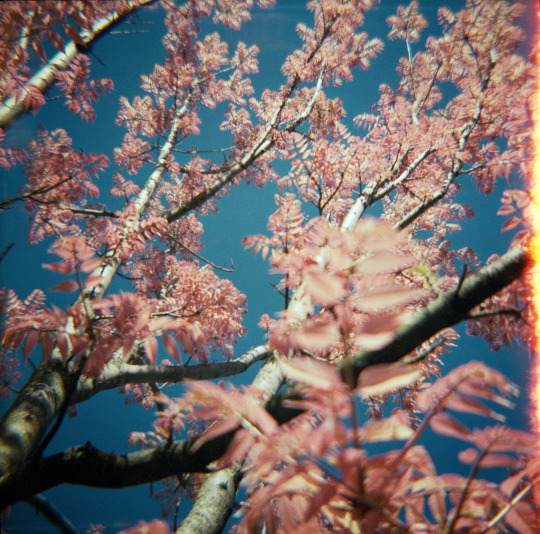
Le cédréla a mis ses feuilles.
1 note
·
View note
Photo



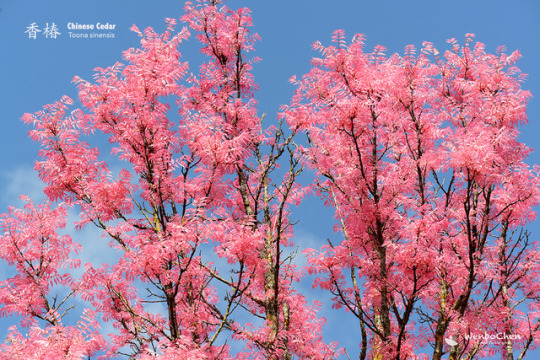
Toona sinensis in Dandenong Range of Melbourne.
1 note
·
View note
Text
anyone in toronto want to try a new herb?
so my mom came by the other day and apparently our red toon tree (toona sinensis) is fuckin PRODUCING this year and dropped me off a BUSHEL of the leaves. Like way too much for me to reasonably eat before they start to go off. (nutella jar for scale)
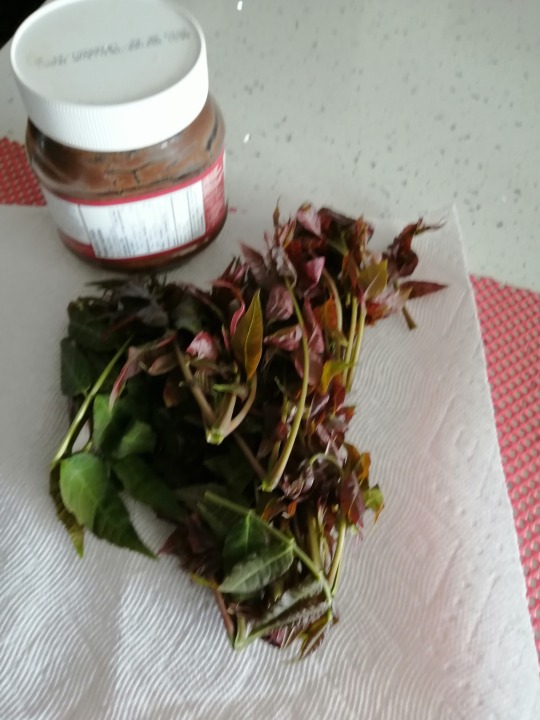
If you live in toronto and would like to try some of this (or swap me some of your own food), dm me and we can figure out a public meetup
I know this herb/veg thingy as xiang chun, but there's like a billion goddamn names for it (here's the wikipedia page)
its really tasty, its like allium lite if that makes sense? bit fragrant, little bit pungent, very light. Easiest way it belongs is in eggs, if you're one to enjoy green onions in your omelettes, egg pancakes, etc these are a really neat treat that you can't buy from shops
389 notes
·
View notes
Text

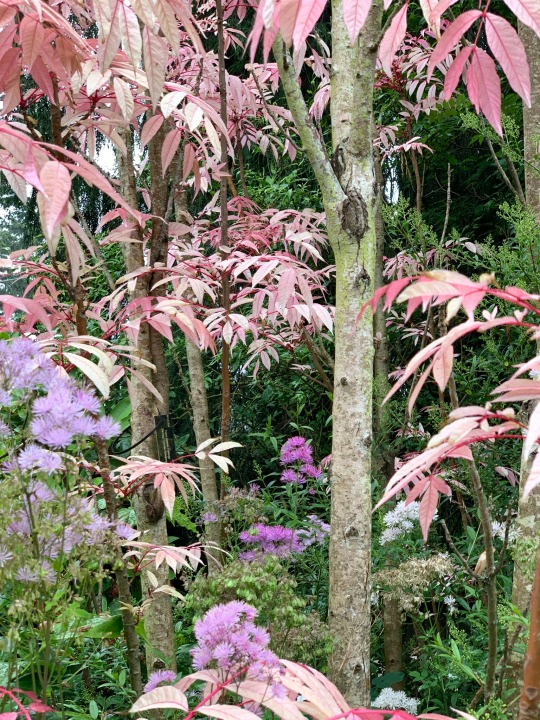
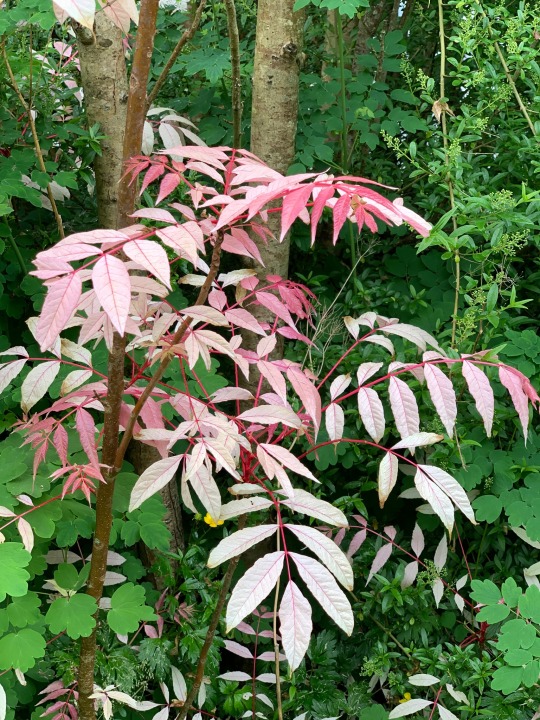
Toona sinensis "Flamingo" at Dart's Hill garden, not quite as pink as when I posted a few weeks ago.
40 notes
·
View notes
Text
A common name for Toona sinensis is the “beef and onion plant” which is very funny to me. Anyways I have seeds for them and I’m hoping I’m able to make them work out! I want to use them as a vegetable! Idk if they can be kept as potted plants though. They’re hardy in the PNW too! And pretty!
I’m going to probably out any extras up for sale in the cafe if I’m successful if anyone wants one!
9 notes
·
View notes
Text
Ma vie au temps du coronavirus
1/03/2020
J’ai passé la journée à attendre des nouvelles de R. L. Vers 21h j’ai reçu un message disant qu’il ne partait pas en Bretagne, mais que les médecins étaient occupés et qu’il fallait rappeler une heure plus tard. A 22h aucun message. J’étais persuadé que c’était mauvais signe. Et seulement maintenant, à 22:30 j’ai reçu le message tant attendu. Il n’est pas parti en Bretagne car le nombre de place était limité, mais sa condition est stable. Le médecin avait l’air optimiste et a demandé d’être patient, vu que cette situation peut durer des jours voire des semaines.
“son état reste stable sur le plan respiratoire. Il a toujours besoin d’autant d’oxygène. Mais il y a quand même une très légère amélioration. Ils ont réussi à diminuer très légèrement les médicaments qu’on lui donne pour le sedater mais il est toujours profondément endormi. Il faudra une bonne semaine avant que l’on ne puisse réellement constater de changement . Le médecin m’a expliqué que l’évolution vers la guérison est toujours très lente dans cette maladie. Donc à nous de nous armer de patience et de continuer notre chaîne de prières et de lui parler au quotidien. Il finira par revenir et nous pourrons ce jour-là faire une grande fête, virtuelle au début avant de nous retrouver tous ensemble un jour.”
J’ai appelé mon amie A. K à Paris, qui avait mauvaise mine et avait une grosse écharpe autour du cou. Elle se plaint d’être épuisée... encore une source de souci. Elle n’a pas voulu continuer la conversation et m’a passé son mari avec qui n’a pas l’air plus soucieux que cela.
Ce matin nous sommes allés à IKEA qui vient de rouvrir ses portes. Vu que les lieux culturels sont fermés, on se venge sur les temples de la consommation. Peu de monde, ce qui n’est pas plus mal car j’ai un souvenir cauchemardesque d’une visite dans ce magasin bondé un samedi.


Badminton l’après-midi. Notre emplacement habituel était occupé par des jeunes qui y jouaient au volley ball. Ils avaient installé un filet entre deux arbres. On a du se réfugier sur une autre placette moins commode. On prend ses habitudes.
Ce soir nous avons mangé un plat à la saveur tout à fait étonnante. Il s’agit des toutes premières feuilles d’un arbre “toona sinensis”xiang chun香椿 que l’on mange en salade avec du tofu. Délicieux mais je pense que vous aurez du mal à en trouver. En Chine ce n’est que quelques jours par an.
1 note
·
View note

